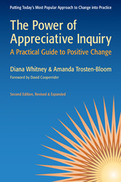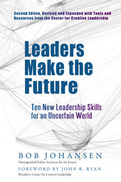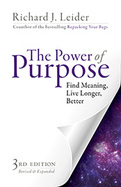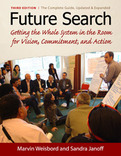2007
Jack Foster's simple five-step technique for solving problems and getting ideas takes the mystery and anxiety out of the idea-generating process. It's a proven process that works. You'll learn to condition your mind to become "idea-prone," utilize your sense of humor, develop your curiosity, visualize your goals, rethink your thinking, and overcome your fear of rejection.
This expanded edition of the inspiring and enlightening classic features new information on how to turn failures to your advantage and how to create a rich, idea-inducing environment. Dozens of new examples and real life stories show that anyone can learn to get more and better ideas.
- A revised and expanded edition of a bestselling classic--more than 90,000 copies sold of the first edition
- This new edition includes to completely new chapters
- Cleverly weaves together exercises, stories, quotations, and illustrations to offer a fun and practical guide to idea generation
The second edition includes new examples, tools, and tips for using AI to create an enduring capacity for positive change, along with a totally new chapter on award-winning community applications of Appreciative Inquiry.
• New edition of the most authoritative, comprehensive, and practical guide to large-scale positive change
• Revised throughout, with new business and nonprofit examples and tools and a new chapter on community-based applications of Appreciative Inquiry (AI)
• Written by two pioneering AI thought leaders
The Power of Appreciative Inquiry describes the wildly popular approach to organizational change that dramatically improves performance by engaging people to study, discuss, and build upon what’s working, rather than trying to fix what’s not. Whitney and Trosten-Bloom provide a menu of eight results-oriented approaches to AI, along with case examples from a wide range of organizations to illustrate Appreciative Inquiry in action. A how-to book, this is the most authoritative and accessible guide to the newest ideas and practices in the field of Appreciative Inquiry since its inception in 1985.
To write the second edition, Whitney and Trosten-Bloom conducted an appreciative inquiry with first edition readers. At the urging of these readers, this edition includes a totally new chapter on community applications of Appreciative Inquiry, along with new examples, tools, and tips for using AI to create an enduring capacity for positive change.
Identifies surprising new leadership skills vital to coping with today's uncertain, rapidly changing world.
-
Identifies surprising new leadership skills vital to coping with today's uncertain, rapidly changing world
-
Includes exercises and assessments for developing and applying these skills
-
A fully updated and revised edition of a book adopted by leaders at Procter & Gamble, Target, McDonalds, Electronic Arts, UPS, Kraft, and many other companies
We are in a time of disruptive change-traditional leadership skills won't be enough, noted futurist Bob Johansen argues. Drawing on the latest ten-year forecast from the Institute for the Future-the only futures think tank ever to outlive its forecasts-this powerful book explores the external forces that are shaking the foundations of leadership and unveils ten critical new skills that will be required in the future, skills that you can learn.
In this second edition, Johansen is joined by the prestigious Center for Creative Leadership. CCL's contributions help readers understand the new leadership skills by linking them to existing skills, and they provide analytics and exercises so readers can develop these new skills.
This edition has been updated throughout, with a new ten-year forecast and new examples, and incorporates the lessons Johansen has learned about applying the new leadership skills in the three years since the first edition appeared. In addition, Johansen deals with two new forces that are shaping the future. The first is the "digital natives"-people fifteen years and younger who have grown up in a completely digital world. The second is cloud-based supercomputing, which will enable new forms of connection, collaboration, and commerce and will greatly facilitate reciprocity-based innovation-giving away to get more-which Johansen sees as the biggest innovation opportunity in history.
- Identifies surprising new leadership skills vital to coping with todays uncertain, rapidly changing world
- Includes exercises and assessments for developing and applying these skills
- A fully updated and revised edition of a book adopted by leaders at Procter & Gamble, Target, McDonalds, Electronic Arts, UPS, Kraft, and many other companies
We are in a time of disruptive changetraditional leadership skills wont be enough, noted futurist Bob Johansen argues. Drawing on the latest ten-year forecast from the Institute for the Futurethe only futures think tank ever to outlive its forecaststhis powerful book explores the external forces that are shaking the foundations of leadership and unveils ten critical new skills that will be required in the future, skills that you can learn.
In this second edition, Johansen is joined by the prestigious Center for Creative Leadership. CCLs contributions help readers understand the new leadership skills by linking them to existing skills, and they provide analytics and exercises so readers can develop these new skills.
This edition has been updated throughout, with a new ten-year forecast and new examples, and incorporates the lessons Johansen has learned about applying the new leadership skills in the three years since the first edition appeared. In addition, Johansen deals with two new forces that are shaping the future. The first is the digital nativespeople fifteen years and younger who have grown up in a completely digital world. The second is cloud-based supercomputing, which will enable new forms of connection, collaboration, and commerce and will greatly facilitate reciprocity-based innovationgiving away to get morewhich Johansen sees as the biggest innovation opportunity in history.
2015
Purpose is an active expression of our values and our compassion for others—it makes us want to get up in the morning and add value to the world. The Power of Purpose details a graceful, practical, and ultimately spiritual process for making it central to your life. This revitalized guide will help you integrate it into everything you do.
This third edition has been completely revised and updated. In addition to new stories, examples, and resources, it features four new chapters. “Purpose across the Ages” looks at how purpose can evolve during our lives. “The 24-Hour Purpose Retreat” includes seven mind-opening questions to help you unlock your purpose. “The Purpose Checkup” offers a new tool for periodically evaluating the health of your purpose. And in “Can Science Explain Purpose?” we learn what researchers are discovering about how an increased sense of purpose can improve our health, healing, happiness, longevity, and productivity.
OST enables self-organizing groups of all sizes to deal with hugely complex issues in a very short period of time. This step-by-step user's guide details what needs to be done before, during, and after an Open Space event.
Harrison Owen details all the practical considerations necessary to create Open Space. He begins with the most important question—should you use Open Space at all?—and examines what types of situations are appropriate for Open Space Technology and what types are not. He then goes on to look at nuts-and-bolts issues such as supplies, logistics, and who should come and how you should go about getting them there.
This third edition adds a survey of the current status of Open Space Technology around the world, an updated section on the latest available technology for report writing (a key aspect of the Open Space process), and an updated list of resources.
Open Space Technology: A Users Guide is just what the name implies: a hands-on, detailed description of facilitating Open Space Technology (OST). OST is an effective, economical, fast, and easily repeatable strategy for organizing meetings of between 5 and 2,000 participants that has been used in thousands of organizations in 134 countries and just keeps growing in popularity. Written by the originator of the method, this is the most authoritative book on the rationale, procedures, and requirements of OST.
OST enables self-organizing groups of all sizes to deal with hugely complex issues in a very short period of time. This step-by-step users guide details what needs to be done before, during, and after an Open Space event.
Harrison Owen details all the practical considerations necessary to create Open Space. He begins with the most important questionshould you use Open Space at all?and examines what types of situations are appropriate for Open Space Technology and what types are not. He then goes on to look at nuts-and-bolts issues such as supplies, logistics, and who should come and how you should go about getting them there.
This third edition adds a survey of the current status of Open Space Technology around the world, an updated section on the latest available technology for report writing (a key aspect of the Open Space process), and an updated list of resources.
2010
-
The latest edition of the classic, definitive book on a change method proven effective worldwide
-
Thoroughly revised and updated, with nine new chapters
-
Provides a wealth of tools, handouts, and other practical aids
Future Search is one of the best established, most widespread and most effective methods for enabling groups of people to collectively move forward. It has been used all over the world for all kinds of purposes: to redesign an IKEA product line in Sweden, develop an integrated economic development plan in Northern Ireland, organize the demobilization child soldiers in Southern Sudan, and help a Hawaiian community reconnect with traditional values, This book, written by the originators of the process, is the most up-to-date edition of the definitive work on this powerful change method.
Incorporating input from the worldwide Future Search community, the third edition has been completely revised, reorganized and updated, including nine brand new chapters. There are new cases and examples throughout, as well as new material on using virtual technologies to hold Future Searches, combining Future Search with other change methods, and the growing global reach of Future Search. Marvin Weisbord and Sandra Janoff have greatly streamlined the process, providing specific guidance for Future Search sponsors, steering committees, participants, and facilitators, and new suggestions for how to sustain action after the Future Search is over. Theyve added information on the economic benefits of a Future Search, striking evidence of Future Searchs efficacy, information how Future Searches can go green, and more.
Future Search uniquely enables people to take down the walls that keep them apart, and Weisbord and Janoff take you through every step of the process. They include a wealth of resources such as handouts, sample client workbooks, follow-up reports, and other practical tools. If you want to do strategic planning, product innovation, quality improvement, organizational restructuring, or any other major change in a participative, whole system way, this book is your guide.
What sets this book apart from similar titles
- Other books in this field, such as Built to Change, contain a bias of top-down design which can make their suggestions unwieldy to implement. This book takes a more grassroots approach to searching for the future, where all stakeholders work cooperatively to create a shared vision of the future.
- It is an optimistic, aspiring book, which describes the change process as "an emotional rollercoaster" which can be upsetting at times but is overall exciting and fun. The Heart of Change Field Guide focuses more on the difficulties and obstacles of leading change within an organization (how to "get around" the people who drag you down, hold you back, etc.) Future Search's emphasis on both positivity and inclusivity sets it apart among change books.
- Future Search methods are so successful, that thousands of people around the world have sought and received training from the Future Search Network: http://www.futuresearch.net/.



















